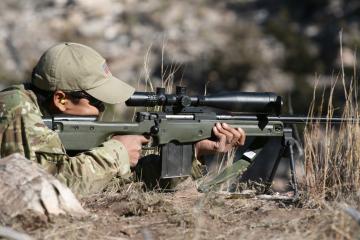It is divided into three sections. The first is about the rifle and gear. The second discusses trajectory and optics selection in depth. The third explains how to put everything together to make hits on targets in the field.
Need training? - Click here for the THUNDER BEAST ARMS TRAINING GROUP

PART I: THE RIFLE & GEAR - priorities, cost, calibers, rifles, ammunition, scopes, range-finders, ancillary gear, spotting, data PART II: OPTICS - ballistics, elevation, wind, lead, data cards, dialing elevation, parallax, first focal plane vs. second focal plane, elevation adjustment & travel, clicks, zero-stop, single- vs. multi-turn knobs, bullet-drop compensators (BDC), tube diameter, reticle features, MIL vs. MOA, reticle illumination, brightness, magnification, objective size, specific recommendations PART III: SHOOTING - zeroing, finding a range, targets and placement, packing up, arrival, target location, positioning, making scope adjustments, engagement, follow-up, shooter/spotter communication, efficiency
Join the discussion: What Is Practical Long-Range Rifle Shooting?
Practical precision rifle shooting involves engaging small and/or
distant targets at the limit of weapon, ammunition, and shooter
capability under time pressure in field settings.
Generally, these include everything a rifleman is likely to find in any "sniper", "tactical", or "field" rifle match. The typical platform is a bolt action rifle, though an auto-loader of sufficient accuracy and appropriate caliber can do the job with some trade-offs. For our purposes, consider "long range" to reach to the load's trans-sonic boundary (the point at which the bullet slows to 15 to 20 percent faster than Mach 1). For example, with typical 308 loads and rifles, we are interested in ranges from 25 yards out to about 700-1100 yards, depending on ambient conditions and the particular load.
Overview
This article, Part III of the series, is intended to cover the "how to" component. Keep in mind
that there is no substitute for actual practice, getting out there and pulling the trigger. After
reading this article, you should know the steps involved in practical long-range rifle shooting and
be able to get out there and start throwing rounds down-range and making long-range hits.

What This Doesn't Cover
This article is intended to explain the practical aspects of long-range shooting. There are many
resources available for pure marksmanship, such as NRA High Power, F-Class, and bench-rest. I
recommend reading David Tubb's books on rifle marksmanship.
|